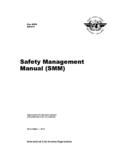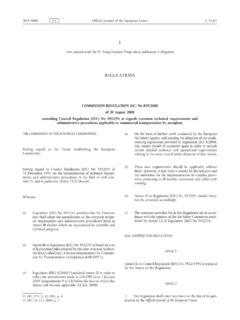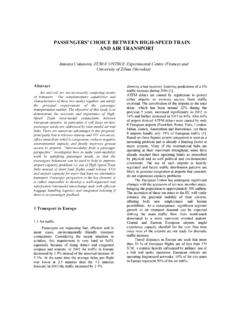Transcription of ACAS II Bulletin no. 14 - SKYbrary
1 January 2012 | N 14 acas II BulletinVersion is WELCOME This issue focuses on a forthcoming change to TCAS II the introduction of the new version A regulatory decision regarding implementation was published in the Official Journal of the European Union on 20 December 2011: all existing TCAS II version installations must be upgraded before 1 December 2015 and new aircraft must be equipped with version from 1 March 2012 to operate in European airspace. The EU Implementing Rule sets an earlier equipage requirements than those published in ICAO Annex 10 (2014 new installations, 2017 existing units). The development of version was initiated by EUROCONTROL following the discovery of two safety issues with the current TCAS II version.
2 Development was undertaken jointly by the RTCA in the United States and by EUROCAE in Europe with support and contributions from several other organizations, including airlines and ANSPs. This Bulletin explains the reasons behind the implementation of version and introduces the new RA the Level off, level off RA. It answers questions that pilots or controllers may have about the new version and provides references to additional training resources. Stanislaw Drozdowski EUROCONTROL Email: Since its introduction in Europe in 2000, TCAS II version has been the subject of monitoring. In the course of analysing recorded and reported events, many cases as many as 23 per year were found in which pilots did not respond correctly to the Adjust vertical speed, adjust Resolution Advisories (RAs).
3 The Adjust vertical speed, adjust RA requires the reduction of vertical speed to 2000, 1000, 500, or 0 ft/min., as indicated on the flight instruments. In those cases involving an incorrect response, the pilots increased their vertical speed instead of reducing it, consequently causing a deterioration of the situation. The Adjust vertical speed, adjust RA is the only RA whose aural annunciation does not clearly communicate what exact manoeuvre is required. It is also the most common RA, representing up to two-thirds of total RAs, all of which increases the potential for incorrect pilot response. Case examples were discussed in acas Bulletins no. 3, 7, and 11 (see Figure 1). Additionally, there have been numerous cases of level bust when pilots following the Adjust vertical speed, adjust RA Adjust vertical speed, adjust RA (1000 ft/min.)
4 FL340FL330 Clear of Conflict 350 ftFL350 Climb, climb RA Clear of Conflict 2500 ft/min. went through their cleared level, often causing a follow up RA for the other aircraft above or below, and disrupting ATC operations (see Figure 2). 500 ft/min. Adjust verticalspeed, adjust RAFL210FL2202500 bust Climb, climb RAVersion problems with Adjust Vertical Speed RAFigure 2: Level bust as a result of Adjust vertical speed, adjust RA 1 Version problems with Adjust vertical speed, adjust RAs 2-3 Version solution new Level off, level off RA 3 Version problems with the reversal logic 3 Version solution improved reversal logic 4 Version Frequently Asked Questions 4 Additional training resources Figure 1: Incorrect response to an Adjust vertical speed, adjust RA Version solution new Level off, level off RAThe issues mentioned on the previous page have led to the development of TCAS II version Occasional pilot confusion with the Adjust vertical speed, adjust RA is resolved by replacing it with a new Level off, level off RA.
5 Currently, Adjust vertical speed, adjust RAs require a reduction of the vertical rate to 2000, 1000, 500 or 0 ft/min. The new Level off, level off RA always requires a reduction of vertical rate to 0 ft/min. The level off is to be achieved promptly, not at the next standard flight level ( FL200, FL 210, etc.). 2000 requires one of these vertical speedsRA requires a level-off (vertical speed 0 ft/min)Version Adjust verticalspeed, adjust RA Level off, level off RAVersion 3: Comparison of Adjust vertical speed, adjust and Level off, level off RAs The aural message Level off, level off also has the benefit of being intuitive and the associated manoeuvre corresponds to the standard levelling off manoeuvre.
6 The Level off, level off RA may be issued as an initial RA (as illustrated in Figure 3) or as a weakening RA (following, for instance, a Climb, climb or Descend, descend RA see Figure 4) when the vertical distance between the aircraft increases after the initial RA has been issued. A weakening Adjust vertical speed, adjust RA in the existing version also always requires a reduction of vertical speed to 0 ft/min. ( level off), so there is no change in pilot actions in these cases. Additionally, replacing the multiple climb/descent rates of the Adjust vertical speed, adjust RA, the Level off, level off RA will minimise the altitude deviations induced by TCAS (level busts while flying the green arc ), thus reducing the impact on ATC operations.
7 Version Adjust verticalspeed, adjust RAFL3300 ft/min. Climb. climb RA Descend, descend RA Level off, level off RA Clear of conflict Clear of conflict 1500 4: Comparison of weakening Adjust vertical speed, adjust and Level off, level off RAs It will contribute to the overall reduction of RA occurrences because follow up RAs resulting from the green arc level bust should not occur any more (see Figure 5). 500 ft/min0 ft/minVersion Adjust verticalspeed, adjust RA Level off, level off RAVersion ft/min2500 ft/minLevel bust Climb, climb RA How the new RA Level off, level off RA is shown on a generic Electronic Flight Instrument System or Instantaneous Vertical Speed Indicator is shown in Figures 6 through 9. Figure 5: How the Level off, level off RA will reduce instances of level bust Figure 6: Level off, level off RA as shown on a generic EFIS display 2 Level off, level off RA continued Figure 7: Level off, level off RA as shown on a generic IVSI display Figure 8: A weakening Level off, level off RA as shown on a generic EFIS displayFigure 9: A weakening Level off, level off RA as shown on a generic IVSI display Learning points new Level off, level off RA: Response to Level off, level off RA: Reduce the vertical rate to 0 ft/min ( level off).
8 The level off must be achieved promptly, not at the next flight level. Adjust vertical speed, adjust RAs will become defunct. Some aircraft will level off hundreds of feet before their cleared level while responding to this new RA. However, the RA will not result in more frequent conflicts with third party aircraft than is experienced with the current version of TCAS. Version problems with the reversal logic The design of the current TCAS II version allows for reversal RAs ( Climb, climb NOW and Descend, descend NOW ) to be issued when the current RA is no longer predicted to provide sufficient vertical spacing. However, there have also been a number of cases in which TCAS IIversion failed to reverse an RA when two converging aircraft remained within 100 feet.
9 This type scenario can occur when one aircraft is not following the RA or is not TCAS II equipped and follows an ATC instruction or performs an avoidancemanoeuvre based on visual acquisition. A number of these types of cases have been discovered each year as many as 7 per year the most notable events being the Yaizu (Japan) midair accident (2001) and the berlingen (Germany) midair collision (2002). Version solution improved reversal logic Version will bring improvements to the reversal logic by detecting situations in which, despite the RA, the aircraft continue to converge vertically. A feature has been added to the TCAS logic which monitors RA compliance in coordinated encounters ( when both aircraft are TCAS II equipped). When version detects that an aircraft is not responding correctly to an RA, it will issue a reversal RA to the aircraft which manoeuvres in accordance with the RA.
10 In single equipage encounters ( when only one aircraft is TCAS II equipped), version will recognise the situation and will issue a reversal if the unequipped threat aircraft moves in the same vertical direction as the TCAS II equipped aircraft. Although the reversal logic change is transparent to flight crews, it will, nevertheless, bring significant safety does not comply with RAor TCAS unequipped aircraft following an ATC instruction or visual avoidanceVersion : No reversal Descend, descend RA Climb, climb RAVersion : Threat s non-compliance detected, reversal RA issued Climb, climb NOW RAFigure 9: TCAS II version improved reversal logic Learning points improved reversal logic: No change in pilot actions: Always follow the RA: Follow the RA even if the RA is contradictory to ATC instructions Respond to reversal RAs within seconds.
















